Syllabus for the next iteration of my seminar “Post-Cinema” (senior capstone / graduate seminar), Department of Art & Art History, Winter 2017.
Tag: post-cinematic affect
Encoding the Future
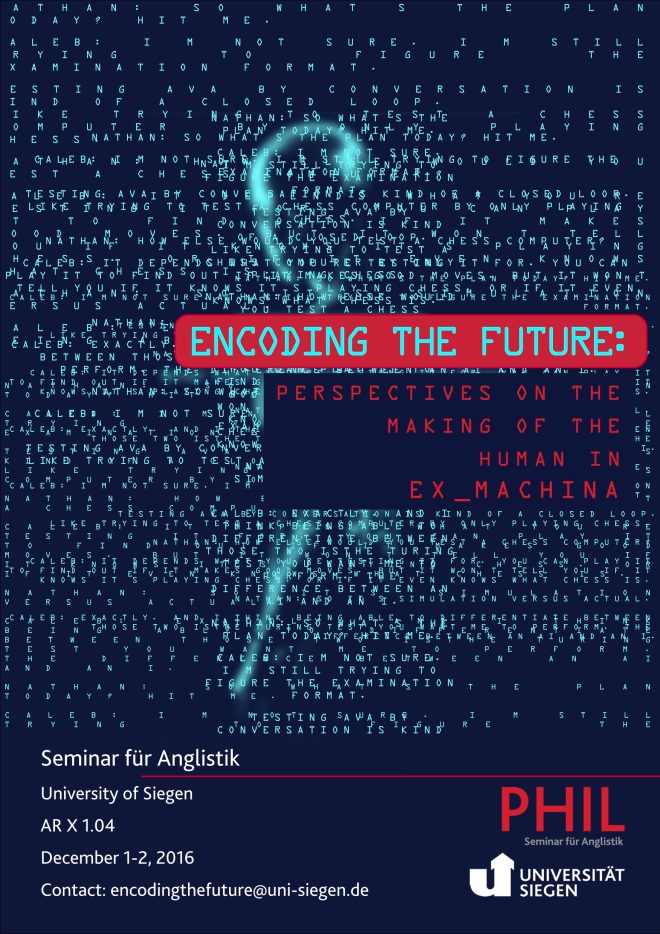
I am excited and honored to be delivering one of the keynote addresses at this conference on “Encoding the Future” at the University of Siegen, December 1-2, 2016. More info and program here.
Affect and Authority

I am honored to be participating in this lecture series at the Heinrich-Heine-Universität Düsseldorf. My talk, titled “Affect and the Authority of Images in a Post-Cinematic Media Environment,” will take place on November 30.
Download PDF — Post-Cinema: Theorizing 21st-Century Film
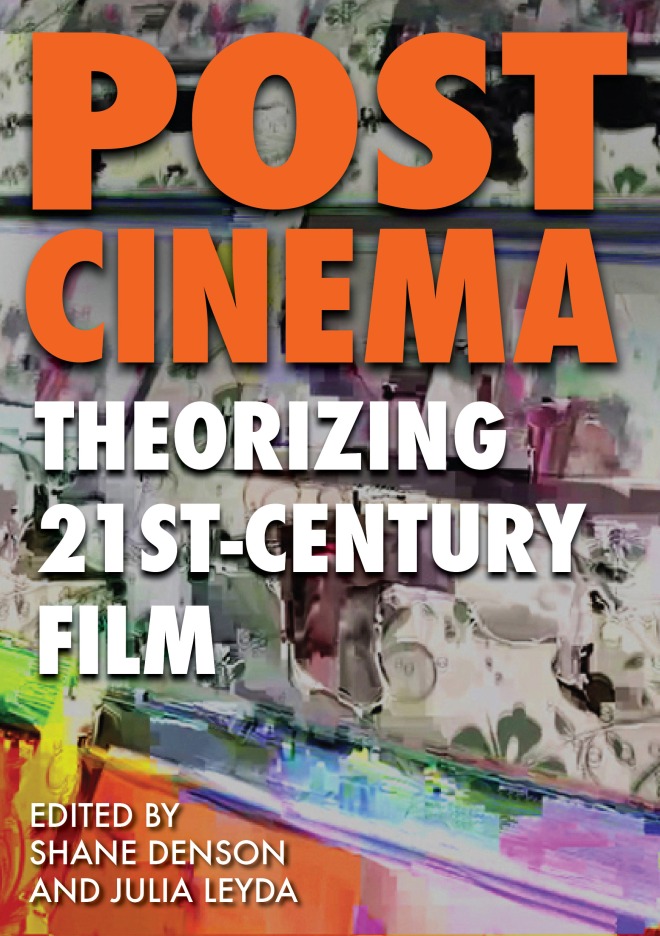
I am pleased to announce that Post-Cinema: Theorizing 21st-Century Film, which I co-edited with Julia Leyda, is now available for download in PDF format.
The open-access book, which has been available in an online HTML version since earlier this year, weighs in at a whopping 990 pages (!) and can now be downloaded for offline reading in two versions (9mb or a higher-quality 13mb version).
There are also two new endorsements for the book. First, from Tanya Horeck at Anglia Ruskin University:
Post-Cinema: Theorizing 21st-Century Film is an intellectually exciting and important book. Editors Shane Denson and Julia Leyda have assembled an extraordinary range of notable contributors with the aim to open up a critical conversation on the very notion of the post-cinematic – something they achieve in a most novel and engaging way. Through essays and roundtable discussions, Post-Cinema formulates fresh and nuanced questions about the consumption and spectatorship of post-millennial film and other media as they circulate through contemporary digital media ecologies. As is fitting given its subject matter of changing media formats, the design and layout of this book – with its open access digitality and its collaborative dialogues – is as relevant and pioneering as its content. Inviting us to rethink received ideas about how 21st-century media reshape “new forms of sensibility,” Post-Cinema: Theorizing 21st-Century Film is critically imperative reading for anyone interested in ongoing vital transformations in moving image media.
– Tanya Horeck, Reader in Film, Media, and Culture, Anglia Ruskin University
And also an endorsement from Michael Lawrence at University of Sussex:
The essays and discussions that have been assembled in Post-Cinema: Theorizing 21st–Century Film provide the reader with a remarkably comprehensive and compelling survey of the diverse critical and theoretical responses to the formal, technological, affective, political and ecological dimensions of our contemporary post-cinematic landscape. That landscape now has an authoritative and inspirational field guide: by gathering together foundational interventions alongside the most recent contributions this collection will prove indispensable to anyone wishing to take these conversations forward.
– Michael Lawrence, Reader in Film Studies, University of Sussex
More info and an official announcement can be found here.
Post-Cinema as a Generative Media Regime — Shane Denson
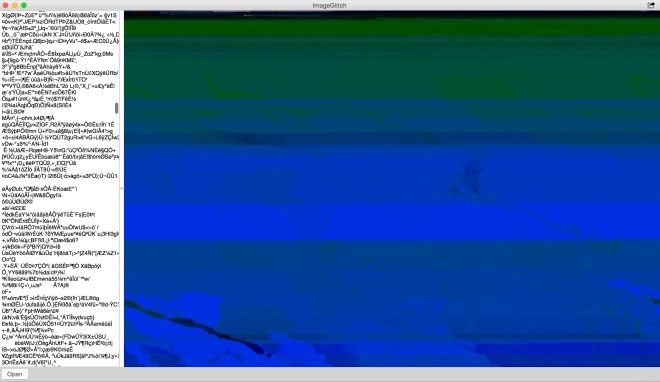
My abstract for the panel “Generativity and Creative Agency in Post-Cinematic Media” at SLSA 2016 in Atlanta:
Post-Cinema as a Generative Media Regime
Shane Denson, Stanford University
This presentation examines recent theories and approaches to post-cinema, understood broadly as the informatically informed audio-visual media regime that follows in the wake of electronic and digital media’s absorption and re-tooling of cinematic technologies and modes of representation. Taking cues from Steven Shaviro’s Post-Cinematic Affect (2010) and the diverse contributions to the collection Post-Cinema: Theorizing 21st-Century Film (2016, co-edited by Shane Denson and Julia Leyda), among others, I aim in particular to foreground the ways in which what has often been conceived in terms of loss (e.g. the loss of indexicality, the demise of celluloid, or the death of cinema as an institution or context for collective reception) inevitably also involves an additive or generative moment—a moment of technical and cultural creation informed by the microtemporal and computational processes that displace and transform the photographic ontology of cinema. Such generativity has been glimpsed in a variety of critical and theoretical statements, such as Lev Manovich’s argument that digital processes render all images “animation,” Steven Shaviro’s focus on “affect” as the pre-perceptual site of these images’ registration, or Vivian Sobchack’s recent meditations on the emergence of a new spatiotemporal dimension within the “screen-sphere” that now encompasses all of human life. As of yet, however, these approaches have not been synthesized into a more general, comprehensive framework of post-cinematic generativity. This talk aims to make a step in this direction by identifying the technical, phenomenological, and pre-personal foundations of the post-cinematic media regime and its particular mechanisms of creative agency.
Post-Cinema (Book Trailer)
Here is a short “book trailer” for the open-access collection Post-Cinema: Theorizing 21st-Century Film, edited by Shane Denson and Julia Leyda (REFRAME Books, 2016).
Also, don’t forget that we’ll be having a book launch party at Pro qm Books in Berlin this coming Friday, June 24. See here for more info and a flyer.
Post-Cinema Book Launch Party
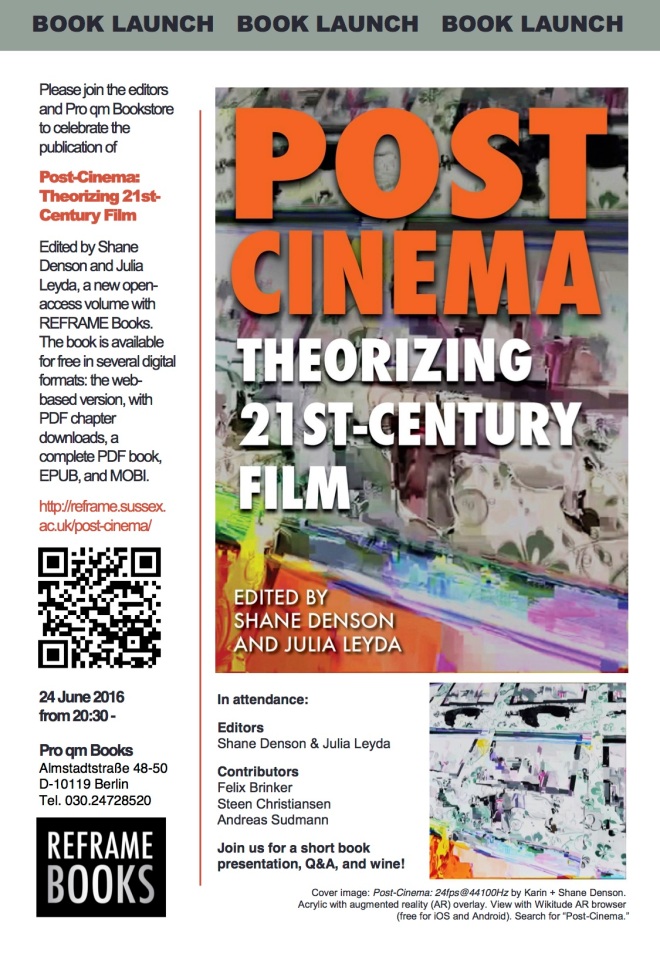
On June 24, 2016, Julia Leyda and I will be celebrating the launch of our co-edited book Post-Cinema: Theorizing 21st-Century Film at Pro qm Books in Berlin. Several contributors will be on hand as well for a short book presentation, Q&A, and wine!
See the flyer above for details, and come out if you’re in the neighborhood!
Out Now — Post-Cinema: Theorizing 21st-Century Film

I am happy to announce, at long last, the publication of Post-Cinema: Theorizing 21st-Century Film, edited by Shane Denson and Julia Leyda, which is out today as a completely free and open-access volume with REFRAME Books.
If cinema and television, as the dominant media of the 20th century, shaped and reflected our cultural sensibilities, how do new digital media in the 21st century help to shape and reflect new forms of sensibility? In this collection, editors Shane Denson and Julia Leyda have gathered a range of essays that approach this question by way of a critical engagement with the notion of “post-cinema.” Contributors explore key experiential, technological, political, historical, and ecological aspects of the transition from a cinematic to a post-cinematic media regime and articulate both continuities and disjunctures between film’s first and second centuries.
The book will appear in several digital formats: the web-based version is online today, and several ebook formats will be appearing soon.
The book brings together foundational texts by some of the key voices in the discussion of post-cinema and places them next to a range of brand-new chapters, as well as a series of roundtable discussions.
The long list of contributors includes:
Caitlin Benson-Allott, Paul Bowman, Felix Brinker, Kristopher L. Cannon, Francesco Casetti, Steen Christiansen, Elena del Río, Shane Denson, Rosalind Galt, Therese Grisham, Richard Grusin, Leon Gurevitch, Mark B. N. Hansen, Bruce Isaacs, Adrian Ivakhiv, Kylie Jarrett, Selmin Kara, Julia Leyda, Patricia MacCormack, Lev Manovich, Ruth Mayer, Michael O’Rourke, Patricia Pisters, Alessandra Raengo, David Rambo, Nicholas Rombes, Sergi Sánchez, Karin Sellberg, Steven Shaviro, Michael Loren Siegel, Vivian Sobchack, Billy Stevenson, Andreas Sudmann
Here is the table of contents:
A brief “press release” with a description of the book and the complete table of contents is available here (opens as a PDF): POST-CINEMA-Press-Release
Post-Cinematic Control #scms16
Full text of my response to a panel at SCMS on “Post-Cinematic Control,” with papers by Lisa Åkervall and Gregg Flaxman:
Post-Cinematic Control: A Response
Shane Denson
It’s an honor and a pleasure to offer a response to this panel on “Post-Cinematic Control” and thus to set the stage for our discussion. Before I get started, I would like briefly to thank Lisa Åkervall for organizing the panel, and thanks to both Lisa and Gregg Flaxman for their excellent papers.
What I want to do is to think about the common base or context that unites these papers. I’d like to start by turning to the panel description that Lisa wrote as part of the proposal process, which I think neatly sums up the overarching questions and perspectives brought together here. She writes:
Today, scholars and critics often allude to a new technological, economic, and even epistemic age, but what is the medial logic that characterizes our brave new world and how has it transformed the very nature of audio-visuality? This panel is dedicated to analyzing the integral function of media in the emergence of the social form that has come to be called “control society”; in particular, the papers brought together here dwell on the “post-cinematic” cultures of image, sound, and affect in control societies. Where “disciplinary” power had previously worked to distribute, segregate, and organize bodies, “control” refers to a relatively fluid space of social relations. The dissolution of institutional milieus (home restriction, privatized HMOs, remote labor, home schooling) is inextricable from the emergence of a new post-disciplinary organization of power. We maintain that, far from concentrating power (in a sovereign) or consolidating it (in social institutions), control relies on post-cinematic media to disseminate power into the most private and unsuspecting of spaces, making its individuals knowable, calculable, and thus controllable.
Hence, this panel is concerned with understanding different dimensions of control by virtue of different aspect of post-cinematic media. More precisely, each paper examines aesthetic instances in which cinema persists as an echo rather than an actuality, whether this entails electronic voice modulation, instantaneous communication, or even the metamorphosizing nature of the cinema itself.
There are a number of things that can be said about this description, but I’d like to highlight and unpack just a few of them.
First of all, the panel is asking about the “medial logic” of our age, and this medial logic is credited with transforming “the very nature of audio-visuality.” Accordingly, this logic of post-cinematic media is seen to be located at an ontological level that is foundational with respect not only to media “contents,” but also to the processes of perception itself. If I am reading this correctly, that is, the transformation of “audio-visuality,” or stronger: the very nature of audio-visuality, cannot be reduced to a change in the objective forms of audio-visual media; it’s not just about new narratives, editing styles, or even image types – but it concerns rather a modulation of sight and sound as sensory channels, or perhaps even a transformation of phenomenality itself.
It is for this reason that the question of post-cinema’s medial logic is here given priority over questions of “a new technological, economic, [or] even epistemic age” – because any medial logic, or any force whatsoever that might be capable of such global modulations, cannot be reduced to the objective or subjective forms of causal processes, rules, rational choices, or knowledge formations. The medial logic at stake here concerns a level of reality that lies deeper than the subject, deeper than its objects, and deeper than any intentional relations between them. It concerns what I have termed the anthropotechnical interface itself: “a realm of diffuse materiality . . ., the relational substrate which underlies the socially, psychically, and otherwise subjectively or discursively organized relations that humans maintain with technologies” (Postnaturalism 26).
Seen thus, as I have written elsewhere, post-cinematic media
serve not as mere “intermediaries” that would relay images neutrally between relatively fixed subjects and objects but . . . act instead as transformative, transductive “mediators” of the subject-object relation itself. In other words, digital and post-cinematic media technologies do not just produce a new type of image; they establish entirely new configurations and parameters of perception and agency, placing spectators in an unprecedented relation to images and the infrastructure of their mediation.
The transformation at stake here pertains to a level of being that is therefore logically prior to perception, as it concerns the establishment of a new material basis upon which images are produced and made available to perception.
(“Crazy Cameras, Discorrelated Images, and the Post-Perceptual Mediation of Post-Cinematic Affect”)
Or, as Mark Hansen has added, upon which they are NOT made available to perception.
In fact, this addition is essential to the perspective being outlined here, which renders the study of post-cinematic media in many ways a speculative undertaking concerned more with ontology than with psychology, but this does not at all mean that it is doomed to being an apolitical perspective. For at stake in these investigations is precisely the material basis of what has been called subjectivation, the material and political process of becoming-subject, which requires for its control, steering, or modulation, the operationalization of forces that are by definition sub-personal or pre-subjective. Accordingly, with post-cinema we enter into
a fundamentally post-perceptual media regime. In an age of computational image production and networked distribution channels, media “contents” and our “perspectives” on them are rendered ancillary to algorithmic functions and become enmeshed in an expanded, indiscriminately articulated plenum of images that exceed capture in the form of photographic or perceptual “objects.” That is, post-cinematic images are thoroughly processual in nature, from their digital inception and delivery to their real-time processing in computational playback apparatuses; furthermore, and more importantly, this basic processuality explodes the image’s ontological status as a discrete packaged unit, and it insinuates itself . . . into our own microtemporal processing of perceptual information, thereby unsettling the relative fixity of the perceiving human subject. Post-cinema’s cameras thus mediate a radically nonhuman ontology of the image, where these images’ discorrelation from human perceptibility signals an expansion of the field of material affect: beyond the visual or even the perceptual, the images of post-cinematic media operate and impinge upon us at what [I have] called a “metabolic” level.
(“Crazy Cameras, Discorrelated Images, and the Post-Perceptual Mediation of Post-Cinematic Affect”)
These are issues that Maurizio Lazzarato has dealt with under the heading of a “video philosophy” – a philosophy of what he calls “machines to crystallize time.” These machines, which are exemplified in the video camera and further perfected in the digital processor, have a direct line on our becoming-in-time, as they operate at a speed that outstrips our cognitive processing and, on this basis, in fact modulate our perception itself.
The question of “control society” is thereby linked to these sub-phenomenal modulations, where the sub-phenomenal subtends and transforms the realm of the phenomenal by enabling new forms of audio-visuality in post-cinematic media. On the one hand, these new audio-visual forms are imbricated in the mechanisms and networks of control, but on the other hand, they offer us sensory spectacles upon which basis we can inquire and speculate on the anthropotechnical and sociotechnical interfaces being mobilized in contemporary subjectivation processes. In other words, these new audio-visual forms might serve as something like what Whitehead calls a “lure for feeling”; we can look to them to discover, speculatively, the operational agencies at work in the constitution of contemporary agency itself.
There is a kind of displacement, a non-actuality, a lack of positivistic self-presence, or what Derrida might call a “spectral” logic implicit in this view of post-cinematic mediation. This is reflected in the panel description in terms of the echo-like relation posited between cinema and post-cinema: “cinema persists as an echo rather than an actuality.” To begin with, this statement militates against ideas of caesura, or the death of cinema, by designating the cinematic as a quasi-virtual moment, a kind of memory-image that supplements and explodes the confines of a punctual present or a concluded past. But the echo, as echo, itself resists confinement to past and present, it is always experienced as movement forward, into the future that it contains and anticipates in its reverberations. Accordingly, we need to supplement this perspective: post-cinema’s relation to cinema is not just one of retention but also protention. It implies what Mark Hansen has called a “feedforward” logic, which is very much the medial logic of control itself.
Again from the panel proposal: “control relies on post-cinematic media to disseminate power into the most private and unsuspecting of spaces, making its individuals knowable, calculable, and thus controllable.” I have claimed that post-cinema, with its microtemporal processing, produces essentially post-perceptual images; here, what Deleuze called the “dividuality” of formerly discrete subjects is enacted at the level of the perceptual object, which is no longer stamped as a discrete photographic entity but modulated as a variable and infinitesimally divisible quantity. The post-cinematic image is generated on the fly, by means of processes that are dependent upon codec settings, available processing power, bandwidth limitations, and buffering, so that the pixillated images we see on our digital devices are in a very real sense data visualizations. And all the while they generate a further stream of data or metadata that delivers information about our attention and perception to corporate interests like Google, Facebook, Microsoft, or Netflix. This metadata, it should be pointed out, is not “meta-” in any metaphysical sense of a detached second-order register; in many ways, it is the primary data, while our sense data is secondary or supplemental for the purposes not only of the money-making machine but also for the production of sense data to come. Futurity is implied in this equation in a way that explodes the simple feedback loop as we have known it. This is not about surveillance, but about control in a newer, non-deterministic and non-disciplinary sense. Wendy Chun reminds us: that “the English term control is based on the French contreroule—a copy of a roll of an account and so on, of the same quality and content as the original” (Control and Freedom 4). As a verb, to control enters into Middle English in the sense of to “to check or verify accounts,” in particular by referring to a duplicate register. But in post-cinematic media the idea of the register, the record, or the memorial function more generally of control shifts to a future-oriented, protentional one, whereby the subject of perception is actively anticipated or called into existence by means of microtemporal calibrations of data and sensory streams.
Portending the future, or better: protending it, these media synthesize time or becoming through the real-time generation of data that point backwards and forward at once. Perception itself is dispersed, along with the data of its generation, between here and there, now and then, between the two rolls or scripts, where the acts of reference and correlation between them explodes the static “now” of either one and enables the generation of new experiences and affects in real time (or, what amounts to the same, in a microtemporal duration that is outside the window of subjective perception).
This, indeed, is the temporal truth of Autotune, as it is explored in Lisa’s paper “The Truth of Autotune”: a real-time input (an audio signal) is analyzed and compared to a set of possibilities (the discrete notes or values inscribed on the contreroule or control script), subjected to modulation accordingly, and made to correspond to the acceptable values before the signal is even made available for perception. Past, present, and future are synthesized here, their discrete natures dissolved in the interplay of script and counter-script. Of course, it is possible to analyze the situation logically or algorithmically, and to study the exact path of the signal with the help of technical instruments, so that we might claim that it only appears that time is subject to transformation. But since it falls beneath the temporal threshold of perception and thus undercuts or bypasses appearance itself, this microtemporal processing does indeed revolutionize time for all intents and purposes – which is to say, for all human intentionalities and telic goals, which are structured in the molar temporal space of gross phenomenality.
And the microtemporal ping-pong that characterizes the Autotune process also conditions digital images in computational video playback, which is especially evident in processes like motion smoothing, where new images are generated on the fly and interpolated between a just-past image and one that is just-to-come, which means that both of them must be assessed and processed before any image is made available for perception.
But how do we get from these low-level processes and infrastructural materialities to the higher-order, sometimes global, and in any case narrative formations discussed by Gregg in his paper “Conspiracy in the Age of Control”? In fact, it’s not such a stretch, I suggest, as these stories of conspiracy and control place computational processes at the very heart of the struggles over political agency and resistance, and they invite us to reflect on the ways that these apparatuses serve as the fulcrum of subjectivation itself and the site of communication between micro-scale materialities and macroscopically narrativizable or cognitively mappable realities.
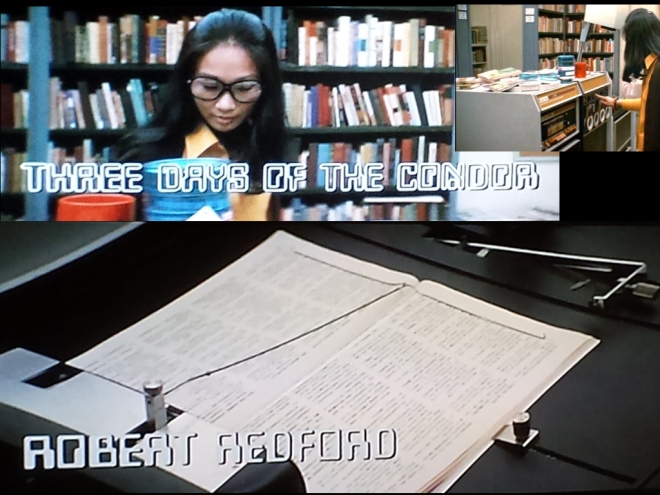
Three Days of the Condor opens with images of a machine for “reading” books, enacting a sort of “distant reading,” as Franco Moretti calls it, by which thousands of books are processed and correlated with one another to reveal humanly inaccessible patterns. Soon we find out that this work is being done for the CIA, thus exposing avant la lettre what Richard Grusin has called “the dark side of digital humanities.” The protagonist, codename Condor, is both a hermeneut and an expert in communications technologies, and it is this combination that not only makes him a digital humanist, of sorts, but that equips him to negotiate between local subjectivities and global networks of conspiracy. His political agency, as Gregg emphasizes, hinges on his cryptographic skills, his ability “to render narrative what might otherwise be noise, coincidence, or nothing at all.” As such, the story is precisely about the media-technical linchpin between a material base or infrastructure of experience and the aesthetic forms it can assume. Confronting us allegorically, as Jameson says about conspiracy movies generally, with the sprawling architecture of the global system of transnational capital, Three Days of the Condor simultaneously confronts us with its computational media-technical underpinnings. The reading machine at the opening of the film is the infrastructural point of passage to the dispersal of agency described with the term “control society.”

And it is in this respect as well that the Bourne movies can be seen, as Gregg has suggested, as an unwitting update of Three Days of the Condor: for not only are these movies about an intensified system of global, dispersed control, but they hinge the question of subjectivation processes on the infrastructure of computation, big data, and – crucially – a global network of cameras, screens, and images. At decisive moments, the film screen becomes, as Gregg puts it, a “data screen.” And here we see that Condor’s struggle (to render machinic information into narrative form) is in fact one of the defining struggles of post-cinema more generally: it is the problem of how to build narrative strands out of (and back into) sprawling transmedial digital networks. In other words, Condor’s reading machine and the reading practices it leverages (which confront mathematical communications technologies with the demands of a hermeneutic or narrative/representational interest) prefigures the network of computers and digital video surveillance cameras featured in Bourne. In many ways, these are self-reflexive spectacles, such that post-cinema figures its own enabling infrastructures and challenges us, in this way, to confront the political processes of subjectivation that inform life today and shape it from the media-technical ground up.
Post-Cinematic Affect, Collectivity, and Environmental Agency #scms16
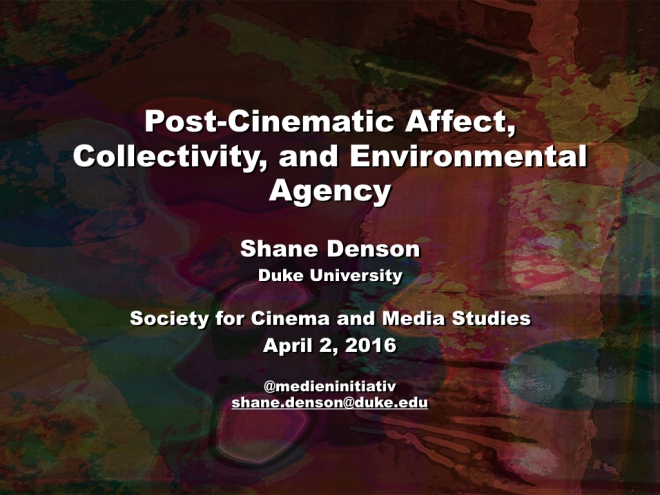
Full text of the talk I presented at the SCMS conference today:
Post-Cinematic Affect, Collectivity, and Environmental Agency
Shane Denson (Duke University)
The computational and broadly post-cinematic media at the heart of contemporary moving images are involved in a massive transformation of human agents’ phenomenological relations to the world. Digital imagery has long been held accountable for effacing the indexicality of cinema’s photographic base, while post-cinematic images more generally might be thought in terms of what I call their “discorrelation” from viewing subjects. However, there is a flip-side to these negative determinations that I want to highlight: if the microtemporal and subperceptual operations of post-cinematic media bypass and hence displace subjective perception, they also serve to expand the material domain and efficacy of sub- and supra-personal affect. What this amounts to, ultimately, is a radical empowerment of the nonhuman environment, the agency of which becomes tangible in sites and forms ranging from the Fitbit to “big data” and the computational modeling of climate change.
In this presentation, which is divided into three sections, I want to take this thought a step further. I want to show, ultimately, that new forms of collectivity may become thinkable and, hopefully, actionable in the spaces opened up by post-cinematic media.
Part 1: Irrational Cameras. Let me start by summarizing an argument I have made elsewhere about the transformation of the camera and its images in a post-cinematic media regime. Post-cinematic cameras – by which I mean a range of imaging apparatuses, both physical and virtual – seem not to know their place with respect to the separation of diegetic and nondiegetic planes of reality; these cameras therefore fail to situate viewers in a consistently and coherently designated spectating-position.
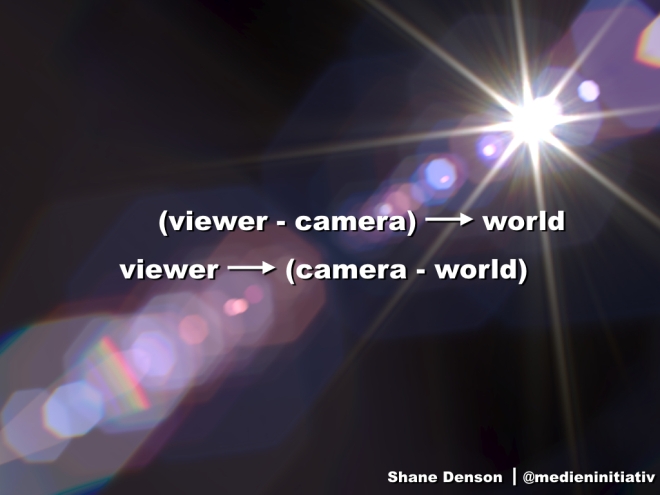
Take the example of the digitally simulated lens flare, which a phenomenological analysis reveals to be riddled with perceptual paradoxes. On the one hand, the CGI lens flare encourages what philosopher of technology Don Ihde calls an “embodiment relation” to the virtual camera: by simulating the material interplay of a lens and a light source, the lens flare emphasizes the plastic reality of “pro-filmic” CGI objects; the virtual camera itself is to this extent grafted onto the subjective pole of the intentional relation, “embodied” in a sort of phenomenological symbiosis that channels perception towards the objects of our visual attention. On the other hand, however, the lens flare draws attention to itself and highlights the images’ artificiality by emulating (and foregrounding the emulation of) the material presence of a camera. To this extent, the camera is rendered quasi-objective, and it instantiates what Ihde calls a “hermeneutic relation”: we look at the camera rather than just through it, and we interpret it as a sign or token of “realisticness.”
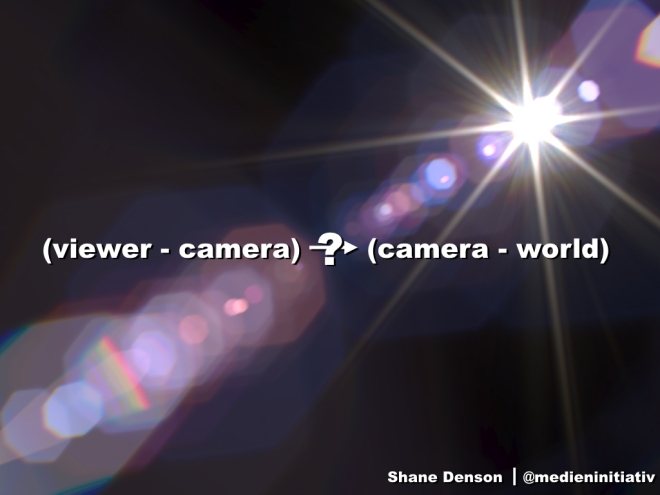
The paradox here, which consists in the realism-constituting and realism-problematizing undecidability of the virtual camera’s relation to the diegesis – where the “reality” of this realism is conceived as thoroughly mediated, the product of a simulated physical camera rather than defined as the hallmark of embodied perceptual immediacy – points to a more basic transformation of mediation itself in the post-cinematic era. That is, the undecidable place of the mediating apparatus, the camera’s apparently simultaneous occupation of both subjective and objective positions within the noetic relation that it enables between viewers and the film, is symptomatic of a more general destabilization of phenomenological subject- and object-positions in relation to the expanded affective realm of post-cinematic mediation. Computational, ergodic, and processual in nature, media in this mode operate on a level that is categorically beyond the purview of perception, perspective, or intentionality. Phenomenological analysis can therefore provide only a negative determination “from the outside”: it can help us to identify moments of dysfunction or disconnection, but it can offer no positive characterization of the “molecular” changes occasioning them. Thus, for example, CGI and digital cameras do not just sever the ties of indexicality that characterized analogue cinematography (an epistemological or phenomenological claim); they also render images themselves fundamentally processual, thus displacing the film-as-object-of-perception and uprooting the spectator-as-perceiving-subject – in effect, enveloping both in an epistemologically indeterminate but materially quite real and concrete field of affective relation. Mediation, I suggest, can no longer be situated neatly between the poles of subject and object, as it swells with processual affectivity to engulf both.

Part 2: The dilation of affect. What I have been describing here is a decentering of human perception and an empowerment of the larger environment. In order to account for this transformation, it will be helpful here to invoke Mark Hansen’s notion of “atmospheric media,” a concept that Hansen develops to explain the experiential impact of computation, but which builds upon Maurizio Lazzarato’s theorization of an affective dimension of video technologies.
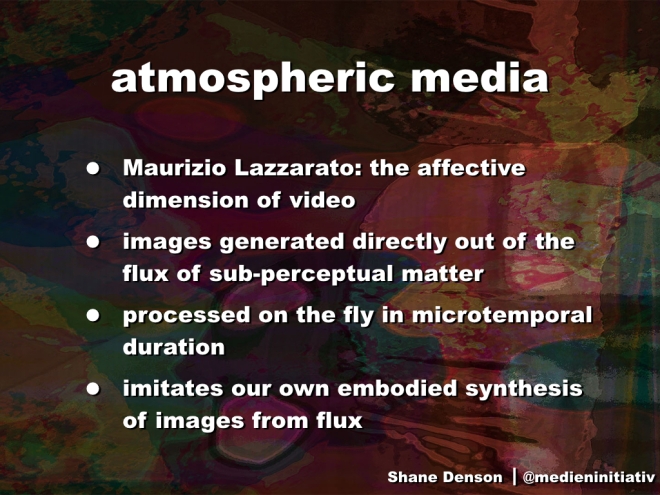
According to Lazzarato, the video camera captures time itself, the splitting of time at every instant, hence opening the gap between perception and action where affect resides (in the metaphysics of Henri Bergson). Because it no longer merely traces objects mechanically and fixes them as discrete photographic entities, but instead generates its images directly out of the flux of sub-perceptual matter, which it processes on the fly in the space of a microtemporal duration, the video camera marks a revolutionary transformation in the technical organization of time. The mediating technology itself becomes an active locus of molecular change: a Bergsonian body qua center of indetermination, a gap of affectivity between passive receptivity and its passage into action. The camera imitates the process by which our own pre-personal bodies synthesize the passage from molecular to molar, replicating the very process by which signal patterns are selected from the flux and made to coalesce into determinate images that can be incorporated into an emergent subjectivity.
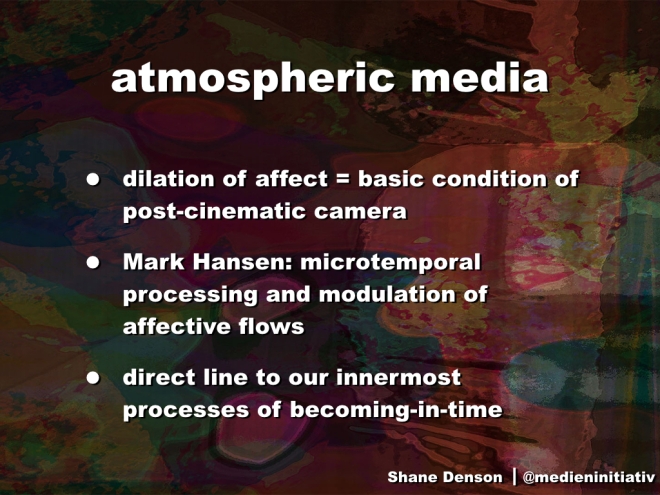
This dilation of affect, which characterizes not only video but also computational processes like the rendering of digital images (which is always done on the fly), marks the basic condition of the post-cinematic camera, the positive underside of what presents itself externally as a discorrelating incommensurability with respect to molar perception. As Mark Hansen has argued, the microtemporal scale at which computational media operate enables them to modulate the temporal and affective flows of life and to affect us directly at the level of our pre-personal embodiment. In this respect, properly post-cinematic cameras, which include video and digital imaging devices of all sorts, have a direct line to our innermost processes of becoming-in-time, and they are therefore capable of informing the political life of the collective by flowing into the “general intellect” at the heart of immaterial or affective labor. Again, this is because the individual’s capacity to perceive is decentered, discorrelated from the perceptual object, and offloaded onto an environment of diffusely “atmospheric” media – including the many screens and cameras, but also the invisible networks and data streams, that surround us everywhere.
Part 3: Post-Cinematic Realism. Paradoxically, these arguments suggest that post-cinematic media – precisely those media widely credited with destroying the index and thus evacuating the political promise of realism – might in fact be credited with a newly intensified political relevance through their institution of a new, post-cinematic realism.
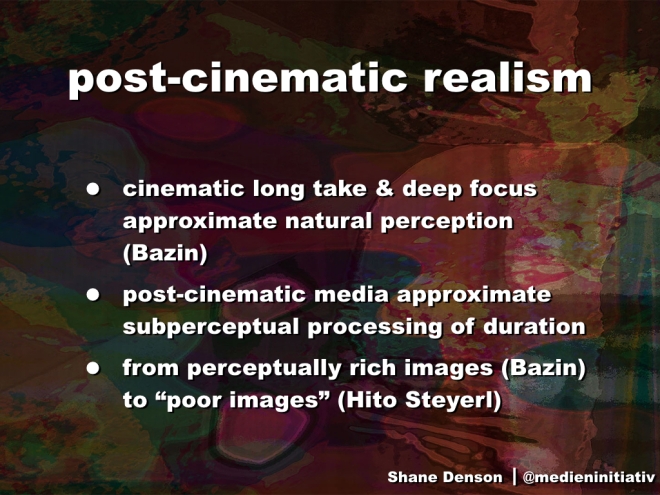
Whereas Bazin privileged techniques like the long take and deep focus for their power to approximate our natural perception of time and space, Lazzarato and Hansen emphasize post-cinematic media’s ability to approximate the sub-perceptual processing of duration executed by our pre-personal bodies. The perceptual discorrelation of images gives way, in other words, to a more precise calibration of machinic and embodied temporalities; simultaneously, the perceptual richness of Bazin’s images becomes less important, while “poor images” (in Hito Steyerl’s term) communicate more directly the material and political realities of a post-cinematic environment.

Consider the 2015 horror flick Unfriended, which is presented as the screen recording of one of the characters’ laptops. Reflecting what Francesco Casetti calls the “relocation” of cinema from the big screen to a variety of little ones, the movie’s sense of “realism” is especially heightened when you watch it on your own laptop. We witness everything on this single screen, through Skype conversations, Facebook chats, email, and web browsing. And it’s essential for the movie that it’s presented in “real-time.” This adds to the temporal urgency and speaks to the reality of our own online communications today, thereby establishing a sense of realism despite the fantastic/supernatural elements at play, and articulating this reality despite—or precisely through—the use of digital glitches. These might otherwise be taken to signal the interruption of realism by the intercession of digital processing that breaks the indexical continuity between image input and image output, but such glitches are a familiar reality of online communication (on platforms like Skype), and our involvement in the images is increased by their use; for example, we might wonder whether the glitches are diegetic, or whether they are produced on our own machine during playback, either due to the buffering processes of online streaming platforms, or because we downloaded a faulty torrent file from some dubious website. Realism here is constructed through an immediacy and direct exploration of the new media-technical conditions of life, to which we can all more or less relate. But in the process the glitches also expose the movie’s singular screen as, in fact, double: the site of playback, traditionally a passive “screening” surface, the screen is also revealed as a newly active site or space in which images are processed and generated before our very eyes. The glitches point up the perceptual paradoxes of post-cinematic cameras, as I’ve described them with respect to CGI lens flares, but they additionally implicate the post-cinematic screen, which becomes ontologically indistinguishable from the camera in its execution of the same material processes of microtemporal and subperceptual image generation.
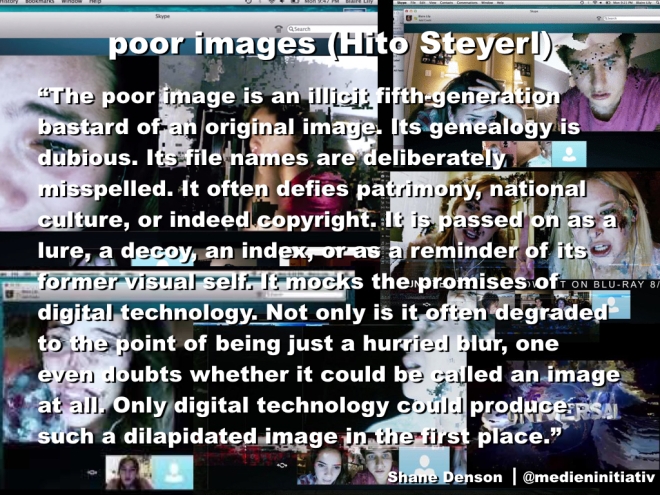
These glitches, and their relation to our contemporary media-technical realities, call attention to what Hito Steyerl has called the “poor images” that circulate in digital networks. Following Steyerl, these images provide an important context for thinking about the political realities of moving-image media today—and an important context for thinking about post-cinematic realism more generally. In Steyerl’s words: “The poor image is an illicit fifth-generation bastard of an original image. Its genealogy is dubious. Its file names are deliberately misspelled. It often defies patrimony, national culture, or indeed copyright. It is passed on as a lure, a decoy, an index, or as a reminder of its former visual self. It mocks the promises of digital technology. Not only is it often degraded to the point of being just a hurried blur, one even doubts whether it could be called an image at all. Only digital technology could produce such a dilapidated image in the first place.” These poor images are close in spirit to the “imperfect cinema” called for in the name of Third Cinema movements, in that they register social marginalization processes while also creating publics of their own. But they also outline the dark side of a “participatory culture,” whose democratic promise is compromised by the hierarchies of value that remain and by the exploitation of unpaid fan labor that is enlisted in the ongoing production-consumption circuits of networked images. Without extracting themselves from these conflicting political trajectories, according to Steyerl, poor images might nevertheless—or precisely for this reason—create what Dziga Vertov called “visual bonds” capable of subverting official and mainstream valuations by expressing what Steyerl terms a “link to the present.” In this way, degraded, glitched-out images might fulfill the political promise of realism precisely through their material connection to the post-indexical infrastructures of moving-image media. In Steyerl’s words: “The poor image is no longer about the real thing—the originary original. Instead, it is about its own real conditions of existence: about swarm circulation, digital dispersion, fractured and flexible temporalities. It is about defiance and appropriation just as it is about conformism and exploitation. In short: it is about reality.”
Like Steyerl, Lazzarato also refers to Vertov and his idea of the “visual bond,” which is seen as a materialist alternative to the critique of ideology, the expression of a practice that addresses the ontology of media directly and prior to the level of content. Essentially, by resisting reduction to human perception, the images of Vertov’s kino-eye are discorrelated from molar experience but thereby opened to the molecular processes by which duration is processed both biologically and technologically, thus getting to the heart of the process by which subjectivities and social collectives are produced. If Bazin described a cinematic realism that draws for its political power on an approximation to perceptual experience, then Vertov marks the path towards a post-cinematic realism that takes aim at the process by which the subject of that perceptual experience takes shape in the first place. It does this, according to Lazzarato, by means of the pre-personal affect that is marshaled and modulated by the increasingly fine-grained “time-crystallizing machines” of cinema, video, and digital processors. Accordingly, the video art of Nam June Paik is seen as a Vertovian answer to television, not because it counters the ideological content of TV but because it probes the machinic time itself of the apparatus, freeing it from the exclusive control of state and corporate interests. The latter, according to Lazzarato, contribute to the production and regulation of political subjects through their control of technical standards (like the PAL and NTSC standards that regulate image frequency, color spectrum, and aspect ratio); because the power to modulate the speeds and images dictated by such standards is “withdrawn from social praxis” (78), our affective powers are impoverished, and we are left with what Lazzarato calls a “‘poor’ perception” (78). The ontology of time-crystallizing machines thus gives way to an ethics or politics of the standards, codes, or protocols upon which images or perceptual objects are formed and synchronized with emergent subjects and social collectives. And because they expose the materiality of digital file formats, video codecs, and compression algorithms, today’s poor images harbor a significant political promise, a potential for resistance that can be deployed creatively against the impoverishment and standardization of perception.

It is debatable, finally, whether a movie like Unfriended actually succeeds in this respect. Certainly, at the level of its narrative, it apparently fails to articulate anything like a model of social-political resistance; if anything, its teenage drama of betrayal, suicide, and revenge, all mediated by the networks and interfaces of social media, and leading to the death of the entire group of “friends,” serves as a critique of contemporary socialization processes – an ideological critique that takes aim not only at online bullying, for example, but that exposes an infrastructure of communication and of intersubjective relation that has rendered the term “friend” itself highly unstable in the age of Facebook. But beyond this more overt political critique of today’s highly mediated forms of collectivity, the movie’s use of glitches serves to focus attention, and to channel affect, at a deeper level, where subjectivity itself is being produced and modulated in an environment of microtemporally operating machines and protocols. Glitches serve at times like micro-cliffhangers, causing us to wait for the image to buffer or clear up so that we can see what’s going on. In this respect, the movie simulates the familiar and yet always disconcerting experience of network lag, e.g. in our own Skype conversations, when the temporal continuity of protentional-retentional experience is interrupted, giving rise to a feeling like that of a cartoon character who has gone over the edge of a cliff, but remains suspended, floating momentarily between the certainty of solid ground and a realization of the situation’s gravity. These micro-cliffhangers focus our attention on the material infrastructure of experience itself, causing us to see pixels as the components but also as material obstacles to vision, blocky screen objects that, despite ourselves, we try to look around to see what’s on the other side. And in this space of the screen, seemingly unitary but, as we have seen, doubled and in fact multiplied even further by the machinic and social networks in which it participates (both diegetically and materially), our vision is dispersed, divided. We are forced to scan the screen for relevant information; our gaze is not sutured, not directed, and to this extent we are hailed not as an integral subject, but as a bundle of affects engaged in a collective effort to perceive—an effort that is both enabled and hindered by the protocols and agencies of the media environment, out of which our subjectivities are wrought. Unfriended may or may not ultimately facilitate our efforts to take control of this experiential infrastructure, but perhaps it succeeds in gesturing towards the fact that this effort must be a collective one, aimed at constructing collectivity in the first place, and that it must be mounted around and in relation to the affective technologies of our post-cinematic environment.

